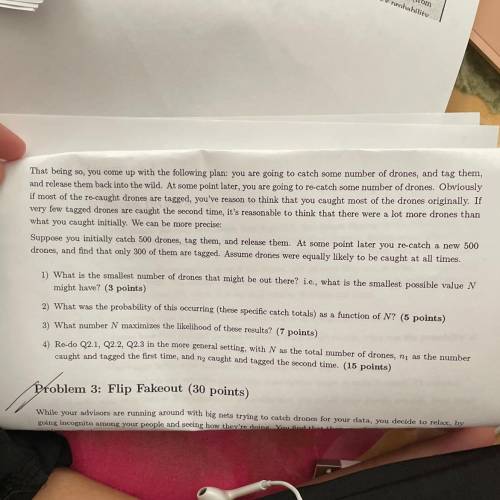delvin7698
10.10.2021 •
Mathematics
That being so, you come up with the following plan: you are going to catch some number of drones, and tag them,
and release them back into the wild. At some point later, you are going to re-catch some number of drones. Obwiously
if most of the re-caught drones are tagged, you've ronson to think that you caught most of the drones originally. If
very few tagged drones are caught the second time, it's ronsonable to think that there were a lot more drones than
what you caught initially. We can be more preciso:
Suppose you initially catch 600 drones, tag them, and relenco them. At some point later you re-catch a new 500
drones, and find that only 300 of them are taggod. Assume drones were equally likely to be caught at all times.
1) What is the smallest number of drones that might be out there? Lo, what is the smallest possible value N
might have? (3 points)
2) What was the probability of this occurring (those specific catch totals) as a function of N? (5 points)
3) What number N maximizes the likelihood of these results? (7 points)
4) Re-do Q2.1, Q2.2, Q2.3 in the more general setting, with N as the total number of drones, n as the number
caught and tagged the first time, and ng caught and tagged the second time. (15 points)

Solved
Show answers
More tips
- H Health and Medicine Simple and Effective: How to Get Rid of Cracked Heels...
- H Health and Medicine Relieving Swelling in Legs: Causes and Ways to Alleviate the Symptom...
- W Work and Career Мерчендайзинг – все, что нужно знать...
- O Other Everything You Need to Know About Kudyabliks...
- F Food and Cooking How to cook crayfish? Everything you need to know...
- F Food and Cooking Homemade kvass: recipe and brewing process...
- H Health and Medicine How to Choose the Right Tanning Cream?...
- S Style and Beauty Secrets of Tying a Pareo: 5 Ways...
- S Sport Running: How to Do It Right?...
- H Health and Medicine Sunstroke: Causes, Symptoms, and Precautions...
Answers on questions: Mathematics
- M Mathematics Part a: which pair of angles are complementary? which pair of angles are supplementary? part b: in the space below, explain your steps on how you determined your answers. be sure...
- M Mathematics Having trouble working out and getting the answer for #5...
- M Mathematics Need ! plzz estimate 51% of 18. (a)9 (b)4 (c)13 (d)19...
- S Social Studies Which of the following statements BEST describes what Enlightenment thinkers, like Jean-Jacques Rousseau believed about women’s rights?...
- H History 2. Sketch: Draw a side view of the plate boundary before and after the plate motion. Draw an arrow to show which way the plate moved....
- H History Pacific Coast Mountains and Valleys...
- S Social Studies The top three producers of agriculture in the world are A Japan Africa and the United States B Japan, England and China C. China India and the United States D. India England and...

Ответ:
hope i helped!